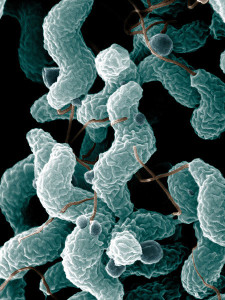At least 6 people who consumed raw or undercooked chicken livers, mostly chicken liver pâté have been infected with Campylobacter in Washington and Oregon.
– A recent study found that about 77% of raw chicken livers are contaminated with Campylobacter.
– Multiple outbreaks of Campylobacter infections linked to chicken livers have been reported in the United Kingdom and Australia.
Raw chicken livers are a high-risk food; risk is reduced by cooking to 165 F and avoiding cross- contamination. It is not easy to tell if pâté is made with safely cooked ingredients as it a blended combination of multiple foods.
Campylobacteriosis is an infection by Campylobacter. The common routes of transmission are fecal-oral, ingestion of contaminated food or water, and the eating of raw meat. It produces an inflammatory, sometimes bloody, diarrhea, periodontitis or dysentery syndrome, mostly including cramps, fever and pain. The infection is usually self-limiting and in most cases, symptomatic treatment by liquid and electrolyte replacement is enough in human infections. The use of antibiotics, on the other hand, is controversial. Symptoms typically last for five to seven days.
The sites of tissue injury include the jejunum, the ileum, and the colon. Most strains of C jejuni produce a toxin (cytolethal distending toxin) that hinders the cells from dividing and activating the immune system. This helps the bacteria to evade the immune system and survive for a limited time in the cells. A cholera-like enterotoxin was once thought to be also made, but this appears not to be the case. The organism produces diffuse, bloody, edematous, and exudative enteritis. Although rarely has the infection been considered a cause of hemolytic uremic syndrome and thrombotic thrombocytopenic purpura, no unequivocal case reports exist. In some cases, a Campylobacter infection can be the underlying cause of Guillain–Barré syndrome. Gastrointestinal perforation is a rare complication of ileal infection.

